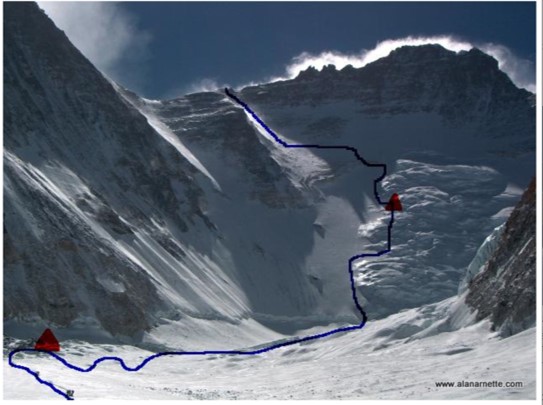Looking ahead: Camp 3 and the Lhotse Face
I've been able communicate with Peter over the past few days via their GPS tracker. It is a little confusing because it doesn't thread the messages but rather I get a bunch of seemingly random pieces of information, some are answering questions I've asked, others are just details about their day. I'm grateful for everything I hear from him.
They've been above Everest Base Camp for a week now. They are still at Camp 2 but he's told me that their Sherpas have gone ahead to prepare Camp 3 (about 24,000 ft.) and that they'll go there soon before returning for a rest back down in Base Camp.
He also says that he can see climbers above him up on the Lhotse face. From their GPS tracks, I can see they went for a walk towards Camp 3 today, still staying on the flat(ish) section of the Western Cwm before the steep climb to Camp 3 starts.
Here's a picture showing the placement of Camp 2 and Camp 3.
To get to Camp 3, they’ll climb the Lhotse face. Here are some details I got from Alan Arnette on what that section is like:
- The face is a steep wall of hard packed ice and snow that holds Camp 3. Climbers climb the Lhotse face twice during the attempt on the summit. First as an acclimatization climb and then on the way to the summit. Climbing the Lhotse Face is a big challenge after the Khumbu Ice Fall on the way to the summit. There are usually two ropes, an up and a down, attached to the face with ice screws and anchors. Each rope is about 200' long so climbers must unclip their carabineers and jumars at the junctions. This is a two step process so that the climber is always attached to the fixed line by at least one device.
- The angle can be very steep especially just above the base or the bergschrund and again near the top most camps. By steep, I mean 40 to 50 degrees. This can be extremely tiring.
- Depending on the weather, the Face is usually rock hard blue ice. Climbers have to kick their crampon points into the ice stealing precious strength with each step. After a few weeks, the path is fairly well set due to the thousands of kicks into the ice but one storm can have climbers starting all over again.
- There are usually two or three levels of camps because flat areas are at a premium and Sherpas need a somewhat flat area to carve out tent platforms. Source: Alan Arnette




No comments: